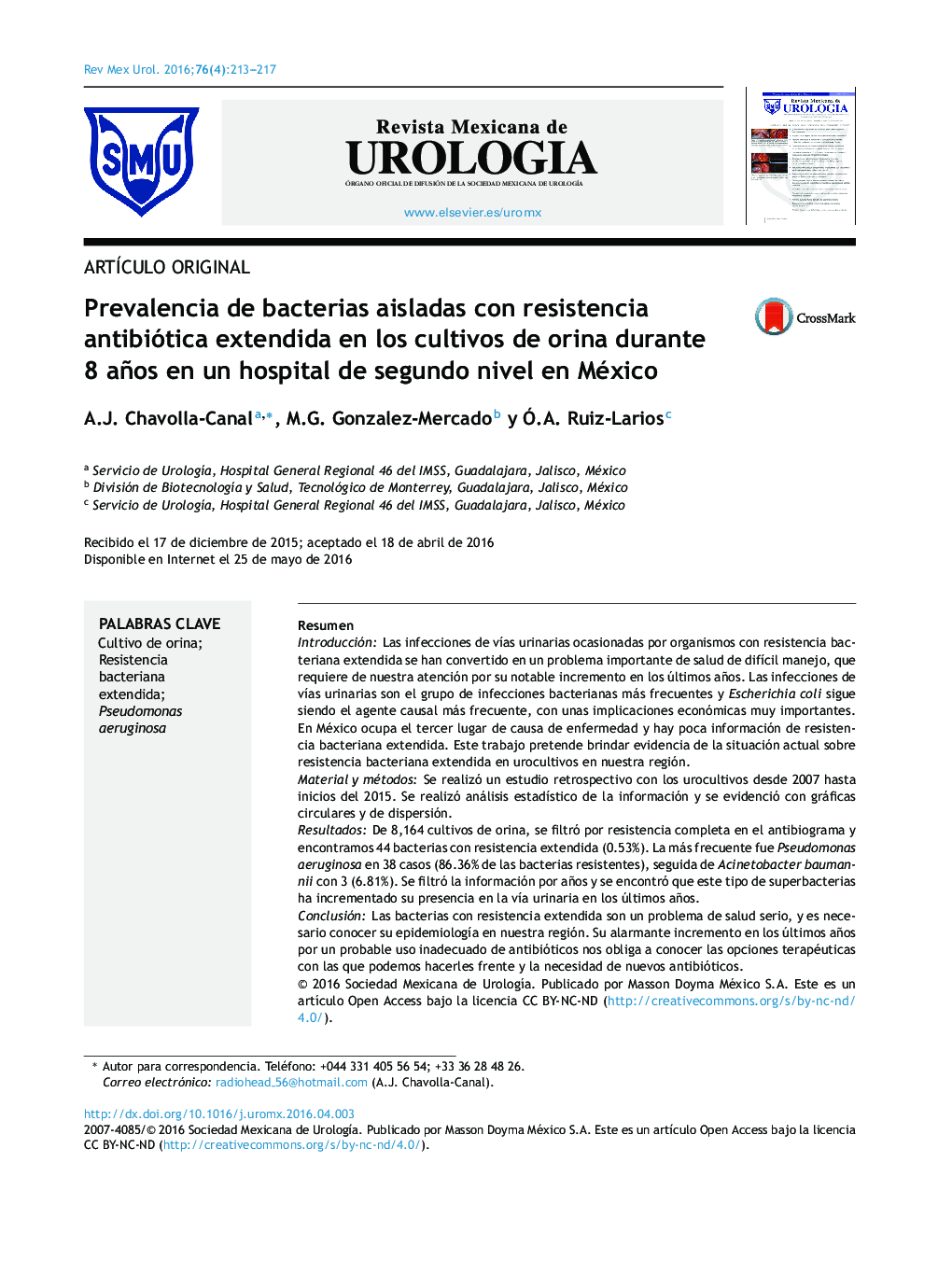| کد مقاله | کد نشریه | سال انتشار | مقاله انگلیسی | نسخه تمام متن |
|---|---|---|---|---|
| 4274275 | 1285252 | 2016 | 5 صفحه PDF | دانلود رایگان |

ResumenIntroducciónLas infecciones de vías urinarias ocasionadas por organismos con resistencia bacteriana extendida se han convertido en un problema importante de salud de difícil manejo, que requiere de nuestra atención por su notable incremento en los últimos años. Las infecciones de vías urinarias son el grupo de infecciones bacterianas más frecuentes y Escherichia coli sigue siendo el agente causal más frecuente, con unas implicaciones económicas muy importantes. En México ocupa el tercer lugar de causa de enfermedad y hay poca información de resistencia bacteriana extendida. Este trabajo pretende brindar evidencia de la situación actual sobre resistencia bacteriana extendida en urocultivos en nuestra región.Material y métodosSe realizó un estudio retrospectivo con los urocultivos desde 2007 hasta inicios del 2015. Se realizó análisis estadístico de la información y se evidenció con gráficas circulares y de dispersión.ResultadosDe 8,164 cultivos de orina, se filtró por resistencia completa en el antibiograma y encontramos 44 bacterias con resistencia extendida (0.53%). La más frecuente fue Pseudomonas aeruginosa en 38 casos (86.36% de las bacterias resistentes), seguida de Acinetobacter baumannii con 3 (6.81%). Se filtró la información por años y se encontró que este tipo de superbacterias ha incrementado su presencia en la vía urinaria en los últimos años.ConclusiónLas bacterias con resistencia extendida son un problema de salud serio, y es necesario conocer su epidemiología en nuestra región. Su alarmante incremento en los últimos años por un probable uso inadecuado de antibióticos nos obliga a conocer las opciones terapéuticas con las que podemos hacerles frente y la necesidad de nuevos antibióticos.
IntroductionUrinary tract infections caused by organisms that are extensively drug-resistant has become an important and difficult-to-manage health problem that requires our attention, given its notable increase in recent years. Urinary tract infections are the most frequent group of bacterial infections, with Escherichia coli continuing to be the most common causative agent, and they have very significant economic implications. Urinary tract infections are the third cause of notifiable disease in Mexico and there is very little information on extensively drug-resistant bacteria.AimThe aim of this study was to provide evidence on the current situation of extensively drug-resistant bacteria in urine cultures in our region.Materials and methodsA retrospective study was conducted on urine cultures from 2007 to the first quarter of 2015. A statistical analysis of the information was carried out utilizing circle and dispersion graphs.ResultsFrom the database, we filtered 8,164 urine cultures by complete resistance results in the antibiogram and found 44 extensively drug-resistant bacteria (0.53%). The most frequent was Pseudomonas aeruginosa in 38 cases (86.36% of the drug-resistant bacteria), followed by Acinetobacter baumannii in 3 cases (6.81%). The information was filtered by year and we found that the presence of these types of super bacteria has increased in the urinary tract over the last few years.ConclusionExtensively drug-resistant bacteria are a serious health problem and it is necessary to know their epidemiology in our region. Their alarming increase in recent years, most likely due to inadequate antibiotic use, makes it essential for us to be aware of the therapeutic options with which we can control these bacteria, as well as highlighting the need for new antibiotics.
Journal: Revista Mexicana de Urología - Volume 76, Issue 4, July–August 2016, Pages 213–217